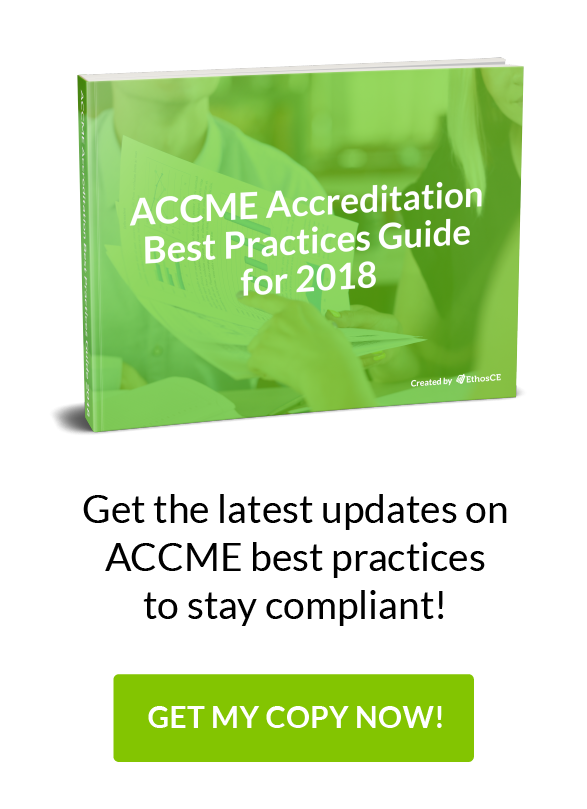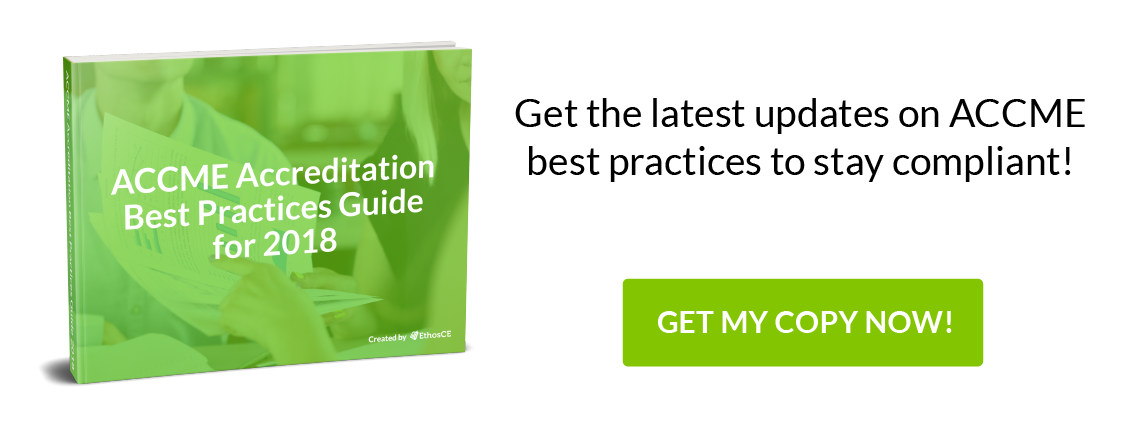3 Things About ACCME PARS You Need to Know
For the ACCME, the Program and Activity Reporting System (PARS) is a reservoir of valuable data which provides the most accurate portrait of your association’s ability to meet the high standards required of CME providers. If you’re a CE coordinator, however, ACCME PARS submissions can be one of the most challenging (and often tedious) elements of CME management. In this post, we’ll look at three important facts about PARS every CE coordinator should know, and discover ways to make the use of PARS a less daunting experience for CME providers.
ACCME PARS 101: A Brief Overview
For many CE coordinators, the most difficult aspect of using PARS isn’t navigating the platform, but the process of developing an approach to data management that simplifies the submission process. CE coordinators must collect, verify, and analyze a wide range of program data, taking care to present clear evidence of consistent compliance with ACCME directives throughout the entire organization. The CE coordinator must then transform this hard data into a coherent, engaging narrative—one that communicates the effect of their association’s unique approach to CME on the overall quality of healthcare.
It’s a tall order, and with so much riding on the ACCME’s interpretation of PARS data, it’s critical your organization streamline the PARS data submission process. Now let’s take a quick look at a few PARS basics.
3 Things You Need to Know About PARS
-
- How the ACCME Uses PARS Data
The ACCME requires every CME provider to maintain comprehensive records of program operations—from curriculum development practices to the monitoring of commercial interests to activities participation rates— throughout the term of accreditation. The ACCME uses information submitted through PARS to confirm the Self-Study Report narrative and projected learner outcomes are data-driven, rather than anecdotal.
-
- What the ACCME Wants to Know
When reviewing your PARS submissions, the ACCME examines patterns of consistency in program compliance, the quality of critical data, and any available evidence that quality assurance practices are efficient and scalable. What ACCME is looking for is a clear depiction of your association’s ability to maintain an agile CME structure and that they can sustain compliance as learners’ needs change, and administrative challenges emerge.
-
- How Your PARS Data Impacts Your Compliance Status
Whether your program has just won accreditation or is preparing to apply for reaccreditation, the way your PARS data is handled, maintained, and submitted will either support or undermine your association’s compliance status. That’s because effective PARS data management is at the heart of some of the most important aspects of CME standards alignment. These include, among other elements, your association’s ability to:
- analyze its current educational practices,
- determine areas for organizational, administrative, and educational design improvement,
- assess learner outcomes and identify professional practice gaps among learners
- Reporting Activity and Program Data
The following is a list of data CME providers must be entered into PARS to comply with reporting requirements:
- Activity Type (e.g., Course, Regularly Scheduled Series (RSS), Enduring Material, etc.)
- Activity Title
- Activity Date
- Activity Location (Courses and RSS only)
- Reporting Year
The following fields must be filled out to close an activity in PARS:
- Providership (Direct or Joint)
- Hours of Instruction
- Designed to change (Competence, Performance or Patient Outcomes)?
- Changes in (Competence, Performance or Patient Outcomes) evaluated?
- Number of physicians (including residents) who participated in the activity
- Number of other learners who participated in the activity
- Commercial Support Received? (Y/N)
- If Yes, Total Monetary Amount of Commercial Support Received and/or Nature of In-Kind Commercial Support Received
Competencies Addressed - Name(s) of Joint Providers (jointly-provided activities only)
- Name(s) of commercial supporter(s) and monetary amount/nature of in-kind support received from each supporter.
- AMA PRA Category 1 Credit™ Credits Designated
Providers must also enter a complete summary of financial data on the Program Summary tab in PARS for each Reporting Year. Data must include:
- Total amount of monetary commercial support received
- Total advertising and exhibit income received
- Total registration fees received
- Total government monetary grants received
- Total private monetary donations received
The Types of Activities to Report PARS
- Course
- Regularly Scheduled Series
- Internet Live Course
- Enduring Material
- Internet Activity (Enduring Material)
- Journal Based
- Manuscript Review
- Test Item Writing
- Committee Learning
- Performance Improvement
- Internet Searching and Learning
- Learning from Teaching
- Other
PARS Reporting Guidelines
You must submit all program and activity data for the completed Reporting Year and complete the Attestation by the last business day of the following March to allow for the calculation of the Annual Report data. Data entry for the 2017 reporting year for ACCME-accredited providers must be completed April 2, 2018. Providers accredited by a state medical society may be required to complete their 2017 year-end reporting earlier and should verify dates with the accreditor.
The ACCME recently collaborated with following boards to simplify the integration of Maintenance of Certification (MOC) and accredited CME:
- The American Board of Anesthesiology (ABA)
- The American Board of Internal Medicine (ABIM)
- The American Board of Pediatrics (ABP)
- Providers may now use PARS to register their activities for these specialty boards’ MOC programs
- ACCME accredited providers may use PARS to submit information on the Extended-Release and Long-Acting Opioid Analgesics REMS CME activities they provide.
Year-End Reporting Requirements
Each year, accredited providers must meet year-end reporting requirements. Failure to submit the year-end report through PARS by the due date may result in an accredited providers status being changed to Probation. Providers still noncompliant after the ACCME Board of Directors meeting that follows the deadline may have their accreditation status changed to Non-accreditation.
As of 2017, the year-end reporting deadline is the last business day in March for the previous calendar year. Providers accredited by a state medical society should verify due dates with their accreditor—submission deadlines may be earlier.
To fulfill year-end reporting requirements, providers must:
- Confirm or update contact information.
- Enter all activity and program summary data for the year through PARS.
- If your current LMS makes it difficult to view, compile, and analyze user data, then you should look for a CME management that offers LMS services and PARS submissions management.
What to Look for in an All-in-One LMS Solution
For a CE coordinator managing your CME program’s ACCME standards alignment efforts, using a PARS management solution—one that collects, formats, and submits compliance data would eliminate one of your most resource-intensive tasks.
It’s essential that your chosen LMS automates critical administrative tasks. Here are a few attributes of a solid LMS platform:
- Global or course-level dashboards
- The ability to filter data by date and user demographics.
- The option to view activities participation data for all users
- A simple tool to determine learner outcomes using pre- and post-test data
- A framework that accommodates the needs of providers offering MOC 4 Performance Improvement (PI, PIP or QIP) CME activities in alignment with the AMA PRA Category 1™ credit and the Stage A-B-C model
Regarding PARS reporting, you should also look for:
PARS-compliant reporting and integration with ACCME web services, such as ABA, ABIM, and ABP MOC 2 programs
Automated reporting to boards and other external systems, including ACCME PARS, CE Broker, and CPE Monitor, and more.
Managing data collection and PARS submissions doesn’t have to be an overwhelming experience for your association. The EthosCE platform provides a robust, enterprise-class LMS with data management and PARS-compliant reporting as a standard feature. Want to learn more? Connect with us to find out how the EthosCE LMS can transform your association’s CME operations.
 We're now part of the Cadmium product suite! Learn more
We're now part of the Cadmium product suite! Learn more 



Thanks.
Comments are closed.